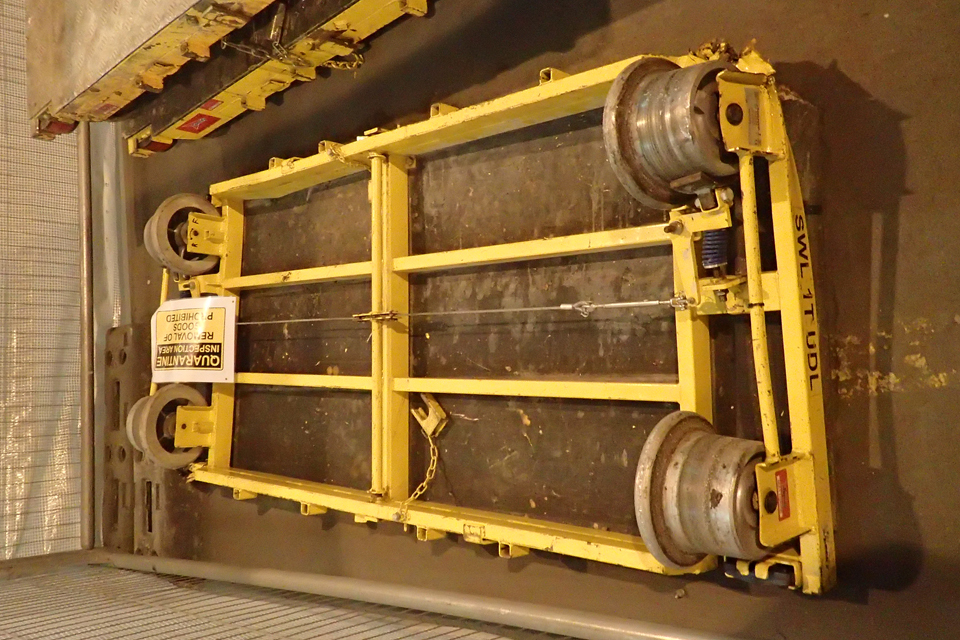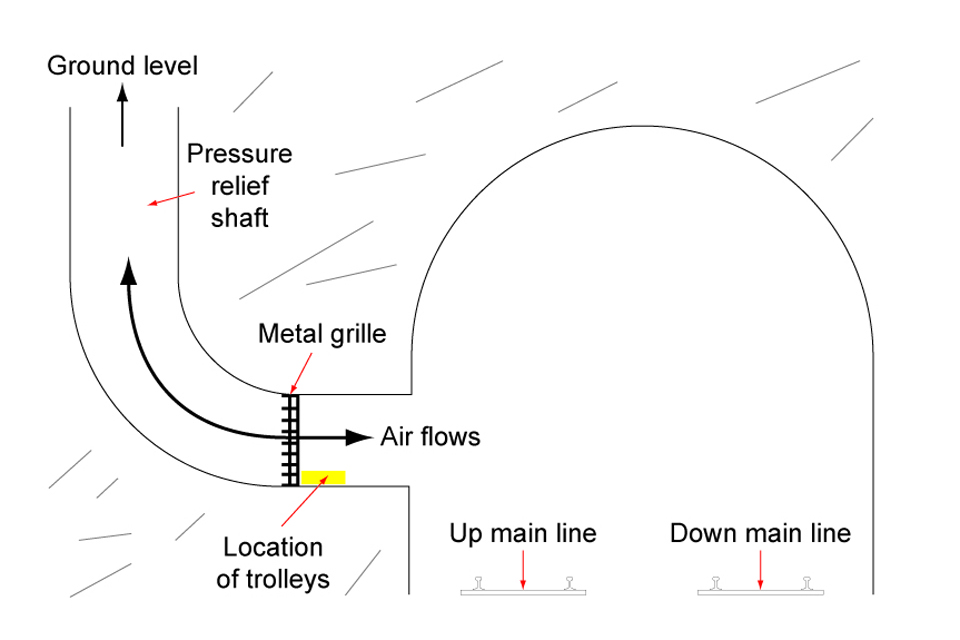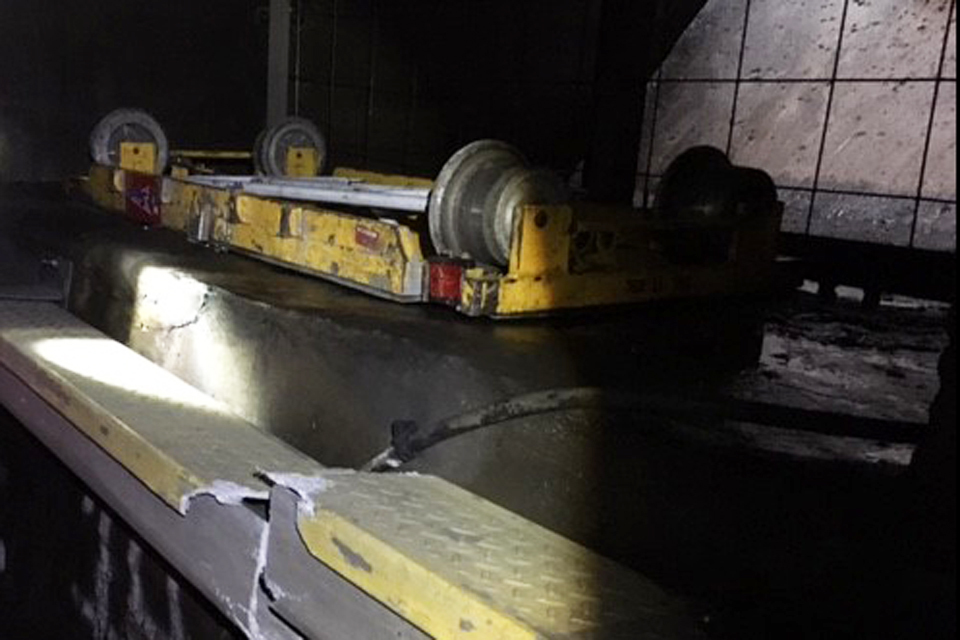Collision between a train and an engineering trolley, Stowe Hill Tunnel, 7 December 2016
Published 31 January 2017
1. Important safety messages
This accident demonstrates the importance of:
- Track workers and managers being aware that the air flows generated within tunnels and pressure relief shafts (where provided) can be significant when trains pass, and are capable of lifting or moving heavy items of equipment unless robustly secured.
- Complying with the rules for securely storing equipment by the line-side (eg using chains and padlocks), not only to stop theft or vandalism, but also, in the case of tunnels, to prevent equipment being swept onto the track by strong air flows. If there is no suitable means of securing the equipment, the safest approach is to not store equipment in a tunnel.
- Including full consideration of where, and how, equipment should be stored during the task planning process and associated risk assessments and not deviating from agreed methods of securing equipment, particularly if storage in tunnels (which leads to increased risk of high aerodynamic forces) is unavoidable.
2. Summary of the accident
At 10:03 hrs on Wednesday 7 December 2016, a class 390 ‘Pendolino’ train operated by Virgin Trains collided with an engineering trolley in Stowe Hill Tunnel, without causing derailment or injury. The train was operating service 1A14, the 08:35 hrs Manchester Piccadilly to London Euston. It passed through the tunnel at a speed of around 120 mph (193 km/h) at the same time as a northbound class 390 service, 9G11, the 09:23 London Euston to Birmingham New Street.
A member of staff on board train 1A14 heard a loud bang and subsequently saw that one of the train’s windows had a broken outer pane. The staff member arranged for the driver to be informed by the train manager, and in accordance with operating procedures for Class 390 trains, the driver then reduced the speed to 100 mph (161 km/h). Virgin Trains reported the accident to Network Rail at approximately 10:10 hrs, but an exact location of the collision was not known at that time.
The train was examined that night at Longsight depot, Manchester, where further damage was found to underframe and bogie-mounted equipment. The discovery of this damage was reported by Virgin Trains to Network Rail at 08:05 hrs on Thursday 8 December 2016. Subsequently, damage to the body side of train 9G11 was also found, but it cannot be confirmed that this damage was also caused by the collision with a trolley in the tunnel.

The yellow four-wheeled engineering trolley found between the Up Main line and the Down Main line with a yellow and back quarantined label
Following the report of 8 December 2016 from Virgin Trains, Network Rail instigated checks of the general area where the damage was reported to have occurred. However, before any such checks could be carried out, the driver of another train reported seeing an unknown object lying by the track in Stowe Hill Tunnel.
Stowe Hill Tunnel is located on a twin-track section of the West Coast Main Line between Rugby and Milton Keynes, approximately 68 miles (109 km) to the north of London Euston. The tunnel is 449 metres long, and comprises a single bore containing two railway tracks. The tracks are designated Up Main line (normally conveying traffic south towards London) and the Down Main line (conveying traffic away from London).
The tunnel has four pressure relief shafts which are vented to the surface. Their purpose is to help reduce the pressure pulses experienced by passengers when trains run in the tunnel. Shaft No.1 is at the southern end of the tunnel and shaft No.4 is at the northern end. Shafts 1, 2 and 3 are located at recesses on the Up side of the main tunnel bore. Shaft 4 is located on the Down side. Each pressure relief shaft has a metal grille to protect the railway from objects being dropped down the shafts.

Cross section through the tunnel showing pressure relief shaft and location of trolley stowage (schematic). The edge of the trolley is 1.77 metres from the Up Main line.
Network Rail staff were sent to Stowe Hill Tunnel on 8 December 2016 in response to the accident reports and discovered four hand pushed trolleys, each weighing 57 kg, within the tunnel in the following states:
- one trolley was between the tunnel wall and the Up Main line and had been completely destroyed;
- a second trolley was located between the Up Main and Down Main lines and had damage consistent with having been struck by passing trains;
- a third trolley was in the recess of pressure relief shaft No.1 and was undamaged; and
- a fourth trolley in the recess at pressure relief shaft No.2, also undamaged.
The two trolleys which had remained in the recesses were reported to be unsecured. However, broken cable ties were subsequently found in the vicinity of the trolleys.

Undamaged trolley as found within the pressure relief shaft No. 1 recess in Stowe Hill Tunnel. The metal grille at the bottom of the shaft can be seen in the background (photo courtesy Network Rail)
3. Cause of the accident
The accident occurred because the trolleys had been stored in the tunnel recesses without being adequately secured and the airflow generated within the pressure relief shafts was large enough to lift and move the trolleys onto the track.
On the night of Sunday 4 December 2016 into Monday 5 December 2016, employees of AMCO Rail had been undertaking brickwork repairs within Stowe Hill tunnel. The AMCO staff used the engineering trolleys to move tools and materials to and from the access point.
The task planning process for this work had originally envisaged using an access point at Weedon, to the north of the tunnel, which was suitable for placing trolleys on the line. The intention was that the trolleys would be removed from the railway after each night’s work and therefore no consideration had been given to any means of storing the trolleys adjacent to the lineside. However, due to an error in the planning process, the access point shown on the Safe System of Work documentation issued to the AMCO staff was shown as Stowe Hill Tunnel. The Stowe Hill Tunnel access point is adjacent to and above the southern tunnel portal. The route from this access point to the lineside requires staff to descend more than 80 steps carrying tools and equipment as required.
During the night of 4/5 December, temperatures dropped and concerns were raised by the AMCO staff working on site that the steps to climb from the lineside back to the access point had become icy, and that therefore it was unsafe to remove the trolleys from the lineside using that route. It was therefore agreed between AMCO and Network Rail staff on site that the trolleys could be left in the recesses within the tunnel. Network Rail staff stated that the trolleys must be secured to ‘something solid’ using chains and padlocks.
However, at the end of the planned work, and after the Network Rail staff had left site, the AMCO staff realised that they did not have any chains or padlocks available. They reported that the four trolleys were placed and secured in the recesses at No.1 and No.2 shafts, two per recess. In each recess, one trolley was placed on top of the second, and they were secured to the grille using cable ties.
On 7 December 2016, trains 1A14 and 9G11 passed within the tunnel in the vicinity of No.1 and No.2 shafts. The forces acting on the trolleys due to the airflow produced in the pressure relief ducts when the two trains passed, caused the upper trolleys in each recess to be lifted by the airflow. One of the trolleys became airborne to the extent that it was able to clear the Up Main line and land in the area between the two railway lines in the tunnel.
The railway rulebook (GE/RT8000), Handbook 1, Section 7.1 states that ‘Tools & equipment must not be placed any closer than 2 metres from a line on which a train could pass, unless you are absolutely sure that they will not be hit by a passing train or be moved by the slipstream of passing trains’. In this case the trolleys were less than two metres from the Up Main line, and had not been adequately secured.
4. Previous similar accidents
RAIB report 03/2008 covers the derailment of a train on LUL’s Central Line at Mile End. The train became derailed on a roll of material which had been stored in a cross-passage between tunnels and was dislodged by the air flows generated by passing trains.
RAIB report 13/2013 covers the partial collapse of a structure within Balcombe Tunnel. The forces on this structure were generated by the air flows produced by trains passing at speed through the tunnel.
Network Rail have issued a Safety Bulletin which can be found here, covering the accident at Stowe Hill amongst others.
You can print this safety digest.

